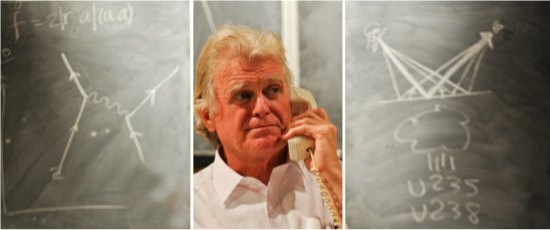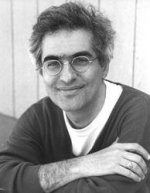Portrait of a physics star as earthly genius bursts from concise frame in bio-drama ‘QED’
 “QED” by Peter Parnell at Collaboraction Theatre, co-produced by theatre4humanity, through Dec. 9 ★★★
“QED” by Peter Parnell at Collaboraction Theatre, co-produced by theatre4humanity, through Dec. 9 ★★★
By Lawrence B. Johnson
Richard Feynman (1918-1988) was a theoretical physicist with both feet planted on terra firma. He was equally famous for his contributions to the study of quantum electrodynamics and for his ability to explain such complex ideas in down-to-earth language. By all accounts, Feynman was very much the straight-talking, irrepressible and charismatic genius portrayed by Rob Riley in Peter Parnell’s bio-play “QED.”
In short, Parnell’s near-monodrama — which occupies an enchantingly littered and bescrawled space at Collaboraction Theatre in a co-production with theatre4humanity — rolls pretty much every celebrated fact and anecdote about Feynman’s remarkably diverse and productive life into one day.
 Riley first portrayed Feynman in the 2010 production of “QED” produced by ETOPiA, the Engineering Transdisciplinary Outreach Project in the Arts, at the McCormick School of Engineering and Applied Science at Northwestern University. Maureen Payne-Hahner, who directed that production, has also shepherded this collaborative revival.
Riley first portrayed Feynman in the 2010 production of “QED” produced by ETOPiA, the Engineering Transdisciplinary Outreach Project in the Arts, at the McCormick School of Engineering and Applied Science at Northwestern University. Maureen Payne-Hahner, who directed that production, has also shepherded this collaborative revival.
Like any visitor to the private study in Feynman’s home, we have some time to take in take in the scene before the man appears. It’s pretty amazing what designer Courtney O’Neill has wrought, this highly personalized mélange of paper-strewn desk, random objects collected over a lifetime and the mental notes, equations and illustrative diagrams that cover blackboards on all sides of the room.
Are we about to learn what all these formulas mean? Or if we’ve forgotten everything we ever knew about quantum electrodynamics, and we’ve neglected to bring a notebook and pencils, will we simply be left by the side of the road, mystified and covered in chalk dust?
Not at all. “QED” is about the man, not the math. And Riley jumps into the physicist’s skin as if he’d been born wearing it. Tall, silver-haired, slightly stooped and shambling, the actor catches the full light of Feynman’s embracing spirit, his curiosity, imagination and obstinacy. It was the last of these qualities – combined with his insatiable appetite for detail — that led Feynman, as a member a presidential commission investigating the 1986 Challenger disaster, to a conclusion that NASA apparently endorsed only with reluctance: that engineers’ warnings about the fatal design flaw had been ignored at the administrative level.
 Parnell doles out these well-known Feynman fragments in neat little packages, some in the form of phone calls we monitor from his end, others in his direct addresses to the audience. Thus we hear the story of how, as a member of the Manhattan Project working on the atomic bomb at Los Alamos, he beguiled the hours of boredom by learning to pick locks. His graduation exercise, so to speak, was a prank: He left a series of unsettling notes in the cabinets that held the top-secret files of his colleagues.
Parnell doles out these well-known Feynman fragments in neat little packages, some in the form of phone calls we monitor from his end, others in his direct addresses to the audience. Thus we hear the story of how, as a member of the Manhattan Project working on the atomic bomb at Los Alamos, he beguiled the hours of boredom by learning to pick locks. His graduation exercise, so to speak, was a prank: He left a series of unsettling notes in the cabinets that held the top-secret files of his colleagues.
Along with these dramatized insights comes an increasing sense of contrivance on the playwright’s part, the dense bundling of information to cover every achievement, every iconic incident, every purple patch of philosophy. To Riley’s credit, and no less to Payne-Hahner’s for her energizing direction, the making of this paint-by-numbers portrait manages to hold our interest to the end, even as the seams show.
 Yet also problematic, and beyond the director’s redemptive means, is Parnell’s decision to drag in a second character, almost by the scruff of the neck. It’s very much a walk-on for Miriam Field as one of Feynman’s students, a pretty girl in whom his professorial interest can perhaps be reduced to that singular figure, that comely integer, standing before us. I won’t disclose how the noble Nobel laureate ends his calculation.
Yet also problematic, and beyond the director’s redemptive means, is Parnell’s decision to drag in a second character, almost by the scruff of the neck. It’s very much a walk-on for Miriam Field as one of Feynman’s students, a pretty girl in whom his professorial interest can perhaps be reduced to that singular figure, that comely integer, standing before us. I won’t disclose how the noble Nobel laureate ends his calculation.
But I will say the coed doesn’t have a lot to do or say, beyond giving the old wizard a reason to live. Ah, I didn’t mention that he’s dealing with aggressive cancer and debating whether to have last-gasp surgery. And we’re expected to believe that this bright-eyed lass, who would so like to become a physicist or mathematician, or somebody really smart just like Feynman, fans his waning spark.
I can’t help wondering whether the playwright, in choosing the title “QED,” the shorthand for quantum electrodynamics, might also have had a double meaning in mind – the Latin quod erat demonstrandum, or “what was to be demonstrated,” which as Q.E.D. sometimes appears at the end of mathematical proofs, as if to say “Voilà!” The theatrical equation here is at least intriguing, if not something to shout about.
Related Links:
- Performance location, dates and times. Details at TheatreinChicago.com
- Richard Feynman explains quantum mechanics: Check it out at YouTube
- Feynman diagrams – a beginner’s guide: Watch it at YouTube
- The Feynman Lectures on Physics: Read them here and test your wits
Tags: Collaboraction Theatre, Courtney O'Neill, Maureen Payne-Hahner, Peter Parnell, Rob Riley, theatre4humanity

